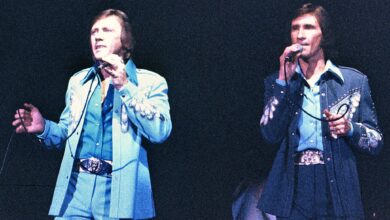Jay & The Americans’ “Come a Little Bit Closer” Brings Latin Heat to American Pop in 1964
When “Come a Little Bit Closer” hit the airwaves in 1964, Jay & The Americans added a vibrant Latin flair to the fabric of American pop music. The song, with its dramatic storytelling and infectious rhythm, quickly climbed the charts, peaking at No. 3 on the Billboard Hot 100. It marked the group’s highest-charting single to that point, a turning point not just for them, but for the evolution of mainstream pop. In an era where British Invasion bands were dominating the charts, this American-made track held its ground—thanks to its unique blend of cinematic narrative, cross-cultural rhythm, and melodic punch.
Jay & The Americans formed in the late 1950s in Queens, New York, and were originally part of the doo-wop explosion that spread through the East Coast. Their earliest hits, like “She Cried,” showed a taste for emotionally rich vocal delivery. With lead singer Jay Black’s operatic tenor and the group’s tight harmonies, they carved out a sound that felt both old-school and forward-looking. Black’s ability to soar into falsetto territory gave their songs a theatrical edge, setting them apart from other harmony groups of the time.
The inspiration behind “Come a Little Bit Closer” was rooted in a desire to tell a story that unfolded like a scene from a movie. Written by the trio of Tommy Boyce, Bobby Hart, and Wes Farrell, the song took listeners on a whirlwind tale of love, danger, and escape. It painted a vivid picture: a man meets a beautiful woman in a Mexican cantina, only to be chased away by her jealous boyfriend. The track’s sense of narrative tension made it not just a song but a miniature drama—complete with characters, setting, and climax.
Recording the song required a carefully crafted atmosphere. Produced by Artie Ripp, the track featured layered percussion to emulate a Latin beat, along with maracas and a distinct flamenco-style guitar rhythm that gave it its unmistakable flavor. Jay Black’s voice, as usual, carried the emotional weight, capturing both the romantic allure and the rising tension of the song’s storyline. The arrangement pulsed with energy, marrying storytelling with rhythm in a way few pop songs of the era dared.
Upon its release, “Come a Little Bit Closer” was an instant hit. It not only secured a place in the Top 5 of the Billboard Hot 100 but also dominated local radio markets, especially in urban areas where Latin American communities resonated with its hybrid sound. Critics praised the group’s bold stylistic shift, applauding their risk in fusing pop vocals with Latin rhythms and storytelling lyrics at a time when the formula for pop success was increasingly conservative.
The song’s success expanded the cultural parameters of American pop music. It helped open the door for more Latin-influenced tracks to gain mainstream airplay and contributed to the rising curiosity around cross-genre experimentation. In a decade marked by musical upheaval, “Come a Little Bit Closer” didn’t follow the wave—it carved its own path. It was a rare example of a song that celebrated cultural blending without resorting to caricature.
For Jay & The Americans, the song marked a career high. It propelled them into larger venues, national tours, and more television appearances. It gave the group renewed credibility and demonstrated they could evolve beyond doo-wop and crooner ballads. Following the hit, the band enjoyed a string of successes, but none as distinct or impactful as “Come a Little Bit Closer.” It showcased their willingness to experiment and redefine their artistic identity.
Beyond their own discography, the song’s impact echoed across the music industry. Its use of narrative storytelling within a pop framework inspired other artists to weave plots into their lyrics. In the wake of its success, more groups began incorporating regional and ethnic flavors into their sound, helping to gradually diversify the American musical landscape—well before the era of “world music” became a recognized genre.
Over the years, “Come a Little Bit Closer” has been covered by several artists, most notably country singer Johnny Duncan in the 1970s, who brought a twangy Southern interpretation to the tune. Each cover retained the original’s drama but often emphasized different musical aspects—some leaning into the Latin elements, others foregrounding the romance or danger. The adaptability of the song’s structure and theme made it a perennial favorite across genres.
The song also became a staple of oldies radio and frequently appears on soundtracks and nostalgic compilations. Its cinematic quality led to inclusion in films like Guardians of the Galaxy Vol. 2, introducing it to younger generations. This resurgence in popular culture reminded audiences of how groundbreaking the original truly was. Even decades later, the track continues to resonate because of its energy, its exotic flair, and its universal theme of forbidden romance.
At the time of the song’s release, Jay Black was also dealing with growing fame and the strain of constant touring, which would eventually contribute to later disputes over the band’s name and royalties. Still, in 1964, all eyes were on their meteoric rise, and “Come a Little Bit Closer” was at the heart of it.
Long after its chart success faded, the legacy of “Come a Little Bit Closer” has endured. It remains one of the earliest examples of Latin-pop crossover in mainstream American music—a predecessor to the genre-bending hits of Santana, Gloria Estefan, and later, artists like Shakira. It proved that rhythm and storytelling could transcend borders and languages, and that American audiences were ready for something more colorful, more layered, and more international.
Perhaps most importantly, the track helped shift how pop songs could be structured and performed. It demonstrated that narratives—complete with plot twists and visual imagery—had a place in music. In doing so, it blurred the lines between music and theater, giving rise to more ambitious pop compositions throughout the late ’60s and ’70s.
Though Jay & The Americans never again reached quite the same commercial peak, they secured their place in history with this hit. And for all the innovation that came after, “Come a Little Bit Closer” remains a singular moment when a band took a bold leap, brought something new to American ears, and left an indelible mark on the sound of a generation.
Decades later, the song continues to ignite imaginations. Whether played through a vintage jukebox or streaming in a retro playlist, its rhythm still feels like a heartbeat, its story still unfolds like a short film, and its impact still ripples across the musical timeline—proof that some songs don’t age. They echo.



